Banff is a photographer’s dream.
Picture pristine turquoise lakes. Craggy, snow-capped peaks. Awe-inspiring glaciers. Gushing waterfalls. These are some of the breathtaking landscapes you can capture when visiting some of the best Banff photo spots.
I’d come across hundreds, if not thousands, of photos of Banff on Instagram over the years, intrigued and captivated by its natural beauty. Before I visited Banff for myself, I worried that it wouldn’t live up to the hype, that it wouldn’t be as impressive as it looks in those perfectly captured, perfectly edited photos.
Well, my friends, I’m here to tell you that Banff is even *more* spectacular than it looks in pictures. Everywhere I visited on my Banff itinerary, my jaw was to the floor, in awe at how breathtakingly beautiful it was. There is no filter needed to capture Banff’s beauty – it’s just incredibly stunning, in every single way.
If you’re a photography enthusiast visiting Banff, you’re in for a treat! There are so many incredible Banff photography spots that are teeming with magnificent scenic beauty.
Here are some of the best Banff Instagram spots and photography locations that you absolutely NEED to add to your list!
**This post contains affiliate links. This means that if you make a purchase or booking, I may receive a small commission at no additional cost to you. Pictures & Words is a participant in the Amazon Services LLC Associates Program, an affiliate advertising program designed to provide a means for us to earn fees by linking to amazon.com and affiliated sites at no cost to you.
Planning a trip to Banff? Be sure to also check out my 3 days in Banff itinerary to help you plan the perfect trip!
The Best Banff Photo Spots

Lake Louise
Lake Louise needs no introduction – it is not only *THE* most famous attraction in Banff, it’s one of the most famous lakes in the world.
And so, it should come as no surprise that it’s also one of the top photo spots in Banff.
Surrounded by colossal mountains topped with glaciers, Lake Louise is the crown jewel of the Canadian Rockies. It gets its milky blue-green color from the rock flour reflecting light.
It’s also one of the most accessible lakes in Banff, open year-round and can be enjoyed and photographed without any hiking. As such, it draws a huge number of visitors – some 15,000 a day during the peak season!


The best time to see and photograph Lake Louise in all its glory is during the summer months, when the water has fully thawed and you can really see the blue-green color that the lake is famous for. Do note that the summer months are the busiest at the lake (and Banff in general), so be prepared to deal with tons of crowds and parking woes (you may want to consider taking a shuttle).
Early in the morning is the best time to visit the lake as the water is the calmest and you’ll have the highest chance of seeing the reflections that the lake is known for, which makes it one of the best places to take pictures in Banff. If you come at sunrise, you’ll also catch some gorgeous colors in the sky reflected onto the lake.
Not only that, coming early in the morning is the best chance to avoid crowds – although, not going to lie, you’ll likely see plenty of people even if you show up at 7am (we did). This is nowhere near as bad as the crowds that you’ll encounter at 2pm.


You can also visit later in the day (after 7pm), but we found that the water wasn’t very still.
Most people congregate around the boardwalk right in front of the Fairmont Chateau. I suggest walking further out along the Lakeshore Trail as the crowds thin out a bit and you’ll get some better shots.
If you’re visiting Banff during winter, Lake Louise is one of the most beautiful places you can visit in the park, as it transforms into a magical winter wonderland!

Moraine Lake
Moraine Lake was my absolute favorite lake in the park – its beauty is unmatched. It’s one of my all-time favorite lakes in the world (right up there with Lake Atitlan). Obviously, it’s also one of the best Banff photo spots.
The iconic lake is synonymous with the Canadian Rockies and is one of the most famous sights in all of Canada (heck, it was on the Canadian 20 dollar bill), so chances are high that you’ve seen an image of it at some point.
I’ve seen so many photos of Moraine Lake on Instagram over the years, and it was probably what put Banff on my bucket list in the first place. And let me tell you, it’s even better in real life than in the pictures!
There is only a relatively short window during which you can visit Moraine Lake, as it’s only open from June 1 until whenever the snow starts falling again in the fall (usually by the first week of October). After that, the lake and the road to get to it closes due to high avalanche risk.
Moraine Lake is best photographed from above. You might be figuring out where to go to get the best shots, and you might think that you have to climb up onto some rocks from the lakeshore (yes, people have done it), but don’t do that – you don’t have to!
Instead, simply head on over to the Rockpile Trail, which begins from the parking lot (look for the trailhead on the left, about halfway down the lot). Continue on the trail for 0.5 miles and then you’ll come across, you guessed it, piles of rocks that also are some of the best places to take photos of the lake.


As for the best time to photograph Moraine Lake…well, the short answer is whenever you can actually get there.
This is because getting to Moraine Lake is a bit of a challenge, so actually getting there is kinda a feat in itself (don’t worry, it’s worth it to see one of the most incredible Banff photography locations!).
As of 2023, all private vehicles (except those displaying a disabled placard) are prohibited from driving on Moraine Lake Road. This is because the lake only has a small parking lot that could not accommodate all the people wanting to see the lake. Because of this, people were showing up at 2:30am (yes, you read that correctly) to guarantee that they could visit! Obviously, this was not reasonable or sustainable.
This means that you’ll need to do some advance planning before you visit the lake. Here are your options for how to visit Moraine Lake:
- Parks Canada shuttle: requires advance reservations
- Hop-on, hop-off bus: also makes stops at other top Banff Instagram spots, such as Lake Louise, Johnston Canyon, and the Banff Gondola
- Guided tours: There are plenty of options for guided tours that include Moraine Lake as a stop. One highly-rated option is this open-top, double-decker bus tour.
And the more specific answer for the best time to photograph Moraine Lake is – sunrise.
This is when the light is at its best, and you’ll see the sun peeking out from behind the mountains that surround the lake.
However, since you can no longer just show up and drive to the lake for sunrise, you’ll have to rely on one of the options below to visit at sunrise:
- Moraine Lake sunrise tour: This is a new tour that was launched from one of the most highly rated tour companies in the area. You’ll get round-trip transportation from Banff, enjoy some hot beverages while you enjoy the sunrise, and also get to stop at Lake Louise before the crowds arrive.
- Moraine Lake Bus Company: From a new company that is providing an option for visitors to get to Moraine Lake for sunrise.
- Moraine Lake Sunrise Shuttle: Another new option for transportation for getting to Moraine Lake for sunrise.
- Biking/hiking: This is an option but not recommended, especially if it’s dark or if there are a lot of vehicles on the road. It is about 11km each way.
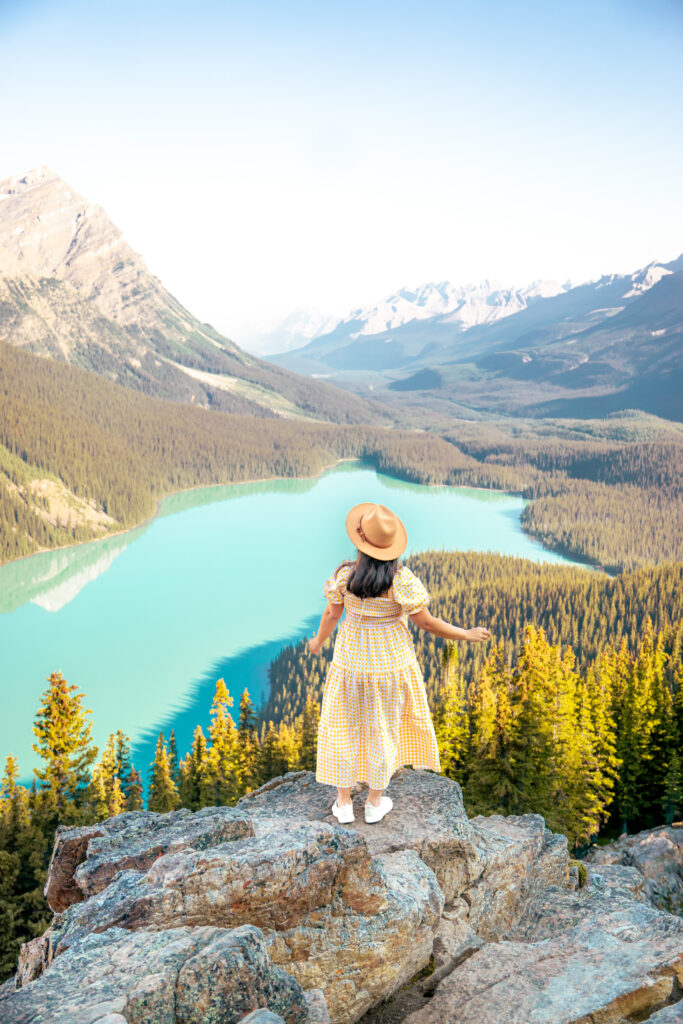
Peyto Lake
Banff has no shortage of photogenic glacial lakes – the lakes here are next level. And so, Peyto Lake is yet another lake that must be included on this list of Banff photography spots.
Peyto Lake is the third most visited lake in Banff, behind Lake Louise and Moraine Lake. Although it may sometimes stand in the shadow of the two latter lakes, it is no less beautiful.
The lake has a unique shape that is said to resemble a wolf’s head (do you see it?), and its vibrant blue color, a result of sunlight reflecting the rock flour in the glacial melt from the mountains above.
Peyto Lake is located along the Icefields Parkway, connecting Banff with Jasper National Park and known as one of the most scenic drives in the world. When driving here, don’t look for a turnoff for Peyto Lake – you won’t find one. Instead, navigate to Bow Summit.
You’ll arrive at the parking lot for the trail to the lake. A short 10 minute walk on a paved trail will bring you up to the viewing deck. You might think that this is already a gorgeous view, but don’t stop there!


I recommend looking for the trail for the second viewpoint. From the main viewpoint, continue along the trail until it forks into three paved parts. Instead, look for a fourth dirt trail, which is unmarked. You’ll want to make sure that the trail you’re on isn’t going downhill because that will lead you to the lakeshore.
The correct trail stays flat and continues through the forest. It can be a bit confusing, but when you’re on the right trail, you’ll know – I know that’s a terrible description, but that’s how my friend Jess described it to me and in hindsight it actually makes sense. You’ll likely also encounter a handful of others going the same way, so you can ask them as well.
You’ll eventually come through a clearing in the forest and the view opens up. Once you see a bunch of rocks, you’ve arrived at the second viewpoint.
We came to Peyto Lake around 8am, since that was the only time we had before we had to head back to the airport. When we arrived, we found that the lake was in the sun, while both of the viewpoints were in the shadows, which made it extra tricky to shoot (yay for Lightroom to the rescue!).
While I usually advocate for coming to shoot early in the morning, I wouldn’t say the same for Peyto Lake. Instead, I’d come when the sun is higher in the sky – this will give you the best vibrant blue color, because of the rock flour reflecting the light.
I’ve also heard that the sunset here is absolutely magical!
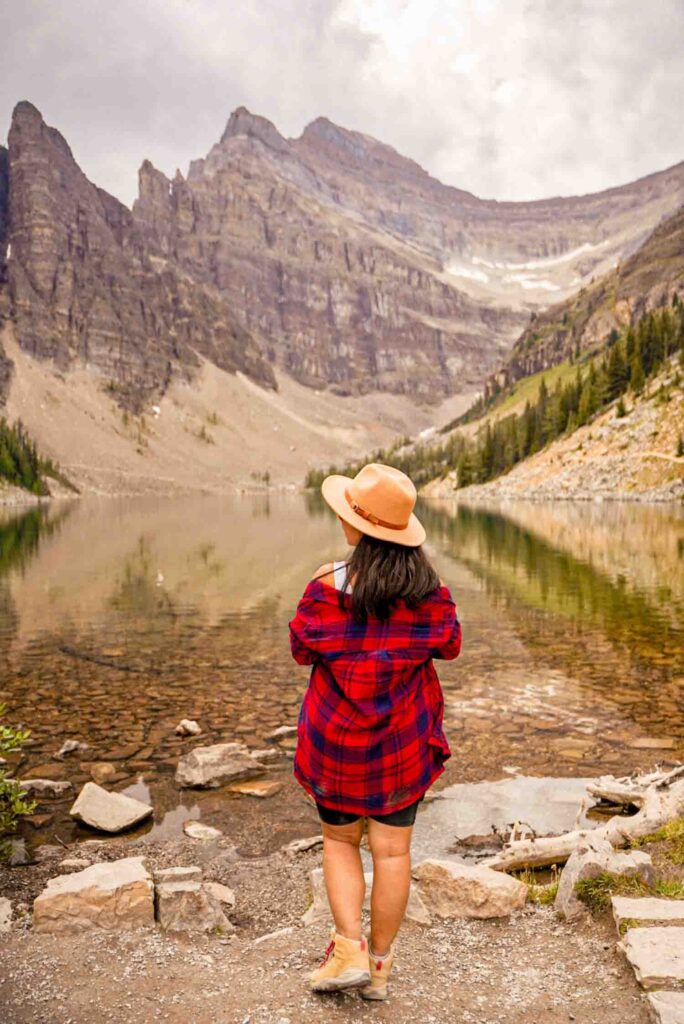
Lake Agnes
This next spot on this list of Banff photography locations requires a little bit of a hike, but it’s beautiful, I promise.
Lake Agnes is one of the most popular hikes in Banff. The trailhead starts from the Fairmont Chateau, and follows the lakeshore until it starts climbing up into the forest. It’s around a 4.5 mile out-and-back hike, and brings you to a pristine lake with some beautiful stillness – you can see the mountains in the background reflected into the water.
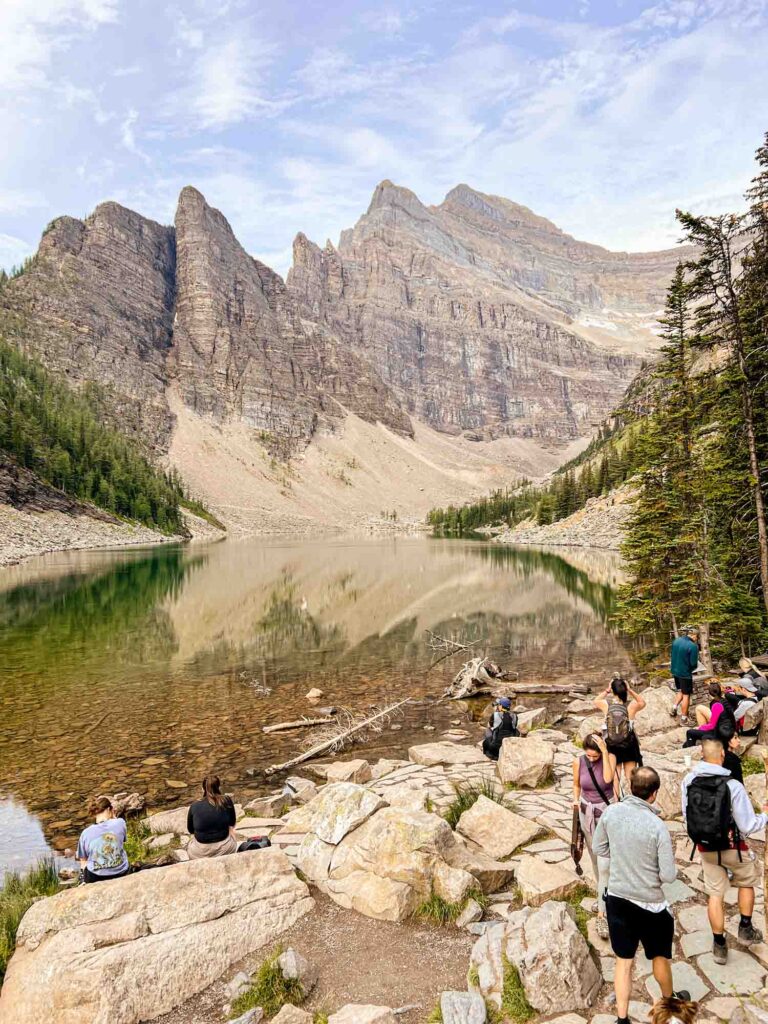


I’d say that the best time to photograph Lake Agnes is in the late spring or early summer, when the trails are clear but there’s still a bit of snow left on the mountains. It really adds a gorgeous touch! We did the hike in late August and there was no snow left on the mountains, but I still thought it was really pretty.
Be sure to also stop at the famous teahouse here, for a bit of a break with some delicious tea, sandwiches, and snacks! The teahouse has no electricity or running water, and the supplies are helicoptered in at the beginning of the season, with the staff hiking in with the rest every day. The tea is actually made using the water from the lake!
Be sure to also walk around the lakeshore and capture the lake from different angles – I thought the view from behind the lake, looking towards the teahouse was really pretty and made for a unique perspective!

Big Beehive
Lake Agnes is also the starting point for several other hikes in Banff. One of these hikes is the Big Beehive, which was one of my absolute favorites!
From Lake Agnes, you’ll have to climb up a series of switchbacks to get to Big Beehive. The switchbacks are STEEP (you can see how steep they are by walking around the shores of Lake Agnes) but they aren’t terrible – and there’s only eight of them, so they’re over pretty quickly.
The view that greets you at the top is what makes the Big Beehive one of the best Banff Instagram spots, and makes the climb totally worth it! You’ll get to see Lake Louise from above, where it looks like turquoise Gatorade, along with a birds-eye view of the Fairmont Chateau.
The trail ends when you come to a wooden shelter. The views aren’t here, but you’ll find them as you walk down the path underneath it.


But, don’t forget to find the viewpoints that are along the trail right before you come to the shelter. I actually think I liked the view from these rather than at the main viewpoint – the trees created a perfect frame, and it had the perfect angle to capture the Beehive itself.
Also, be sure to look in the other direction – opposite of the lake, you’ll find a beautiful view of the mountains and glaciers which are an absolute stunning sight!
If you don’t feel up to the challenge of climbing all the way up to the Big Beehive, consider hiking to the Little Beehive instead. It’s got a similar view in the sense that you see Lake Louise from above surrounded by mountains.
However, since you’re quite a bit higher on the Big Beehive, it’s got a better view – but if you don’t want to work as hard, the Little Beehive is a good alternative. Or, if you REALLY want a challenge, you can attempt both (many people do!).
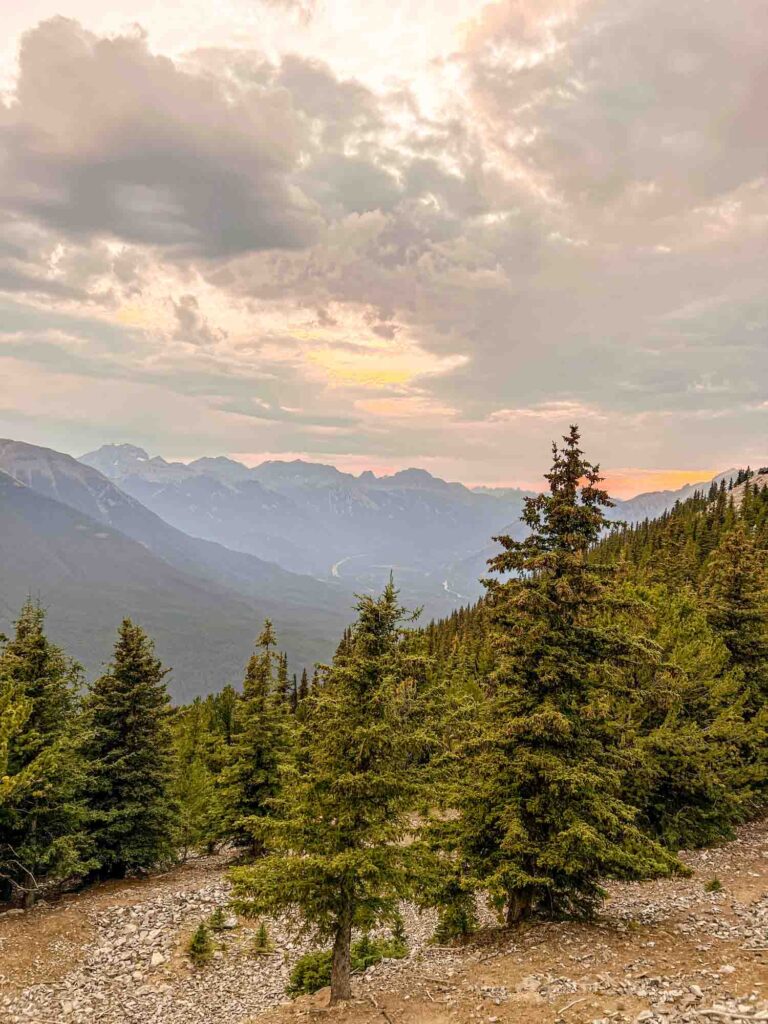
Sulphur Mountain + the Banff Gondola
Taking a ride on the Banff Gondola is one of the most popular things to do in Banff. An eight minute ride takes you up to the top of Sulphur Mountain, 2281 meters (7486 feet) above sea level.
Not only are the views spectacular from here, they are also incredible while you’re on the gondola itself, which makes it one of the top Banff photography spots.
At the top, you’ll find stunning views of the entire Banff area and the valley below. You’ll see the famous mountain peaks, such as Mount Rundle, the town of Banff, Bow Valley, Lake Minnewanka, and much more. It is truly a breathtaking view!
I also recommend walking out to the wooden boardwalk, which brings you to a weather station on Sanson’s Peak. Not only does the boardwalk itself create some awesome photo ops, the view from here is amazing as well!


The best time to do the Banff Gondola is around sunset, but allow yourself a bit of time (at least 1-2 hours) to get to the top and check out everything that’s there! Seeing the sun set against these incredible views was pretty magical.
The Banff Gondola isn’t cheap – it starts at $55 CAD per adult, but can be more expensive if you go during peak times – but it’s one of the most popular things to do in Banff for a reason! I thought it was worth it because the view was pretty incredible, and it was a cool experience.
There’s also plenty to do up at the top, from the open-air observation deck, the boardwalk, a number of restaurants, fire pits, an interpretive center, theaters, and more. You can literally spend hours up here if you wanted to!
I’d recommend booking your tickets in advance to skip the lines and to save a bit of money (and to avoid being let down if it sells out, as it tends to during the busy summer months).
If you are on a budget or really don’t want to spend that much, you can also hike to Sulphur Mountain. Be aware that it’s not an easy hike though – it’s 5.5 kilometers (3.4 miles) one-way, with 655 meters (2148 feet) of elevation gain, with tonssss of switchbacks. You do also have the option of hiking up, and then taking the gondola back down (or vice versa). Honestly, though, there are much better hikes in Banff, so I’d save your energy for those and just take the gondola.
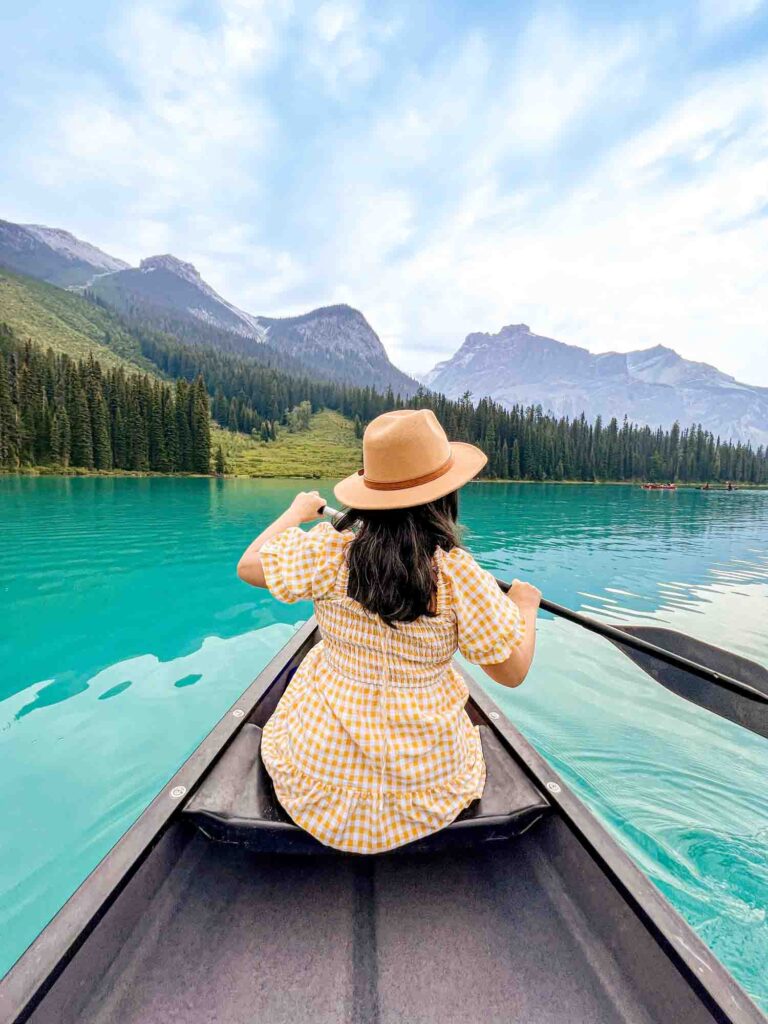
From a canoe!
Another one of the most popular activities in Banff is canoeing. There are so many magnificent lakes in and around Banff, and getting right out *on* the water is one of the best ways to experience them!
Canoeing on Lake Louise is an iconic experience, however it is the most expensive. Canoe rentals cost $135 for 30 minutes, or $145 for an hour for up to 3 people (you do get a huge discount if you’re a hotel guest though). It’s also super popular so expect to encounter crowds and lines.
Moraine Lake is another well-known lake for canoeing – while the lake is spectacular from above, it’s also gorgeous right on the water as well! A one-hour canoe rental here costs $130 CAD for up to three people. Do note that getting to Moraine Lake is, well, a bit complicated these days (see the section on Moraine Lake above on this list of photo spots in Banff for more details).
Another option for canoeing is on Lake Minnewanka. The largest of Banff’s lakes (and one of the closest to Banff town itself), you’ll also find the cheapest canoe rentals here – $85 CAD for the first hour, and $42.50 CAD for each additional hour.
Also consider canoeing on Emerald Lake – this is what we did! While it’s technically outside of Banff and in neighboring Yoho National Park, it’s only about 30 minutes away from Lake Louise. Its waters are, you guessed it, emerald and super gorgeous! We paid $95 CAD for a one-hour rental for three people, which is $50 cheaper than at Lake Louise.

Icefields Parkway
Icefields Parkway, the highway connecting Banff with Jasper National Park, is considered to be one of the most spectacular drives in the world. The 232 kilometer (143 mile) road is filled with scenic pullouts, jaw-dropping views, and plenty of attractions along the way.
It takes about 2.5 hours to drive the entirety of the Icefields Parkway without any stops, but chances are that you’re going to be making plenty of stops because you’ll ooh-ing and aah-ing the entire way. This is exactly why it’s on this list of the best places to take pictures in Banff!
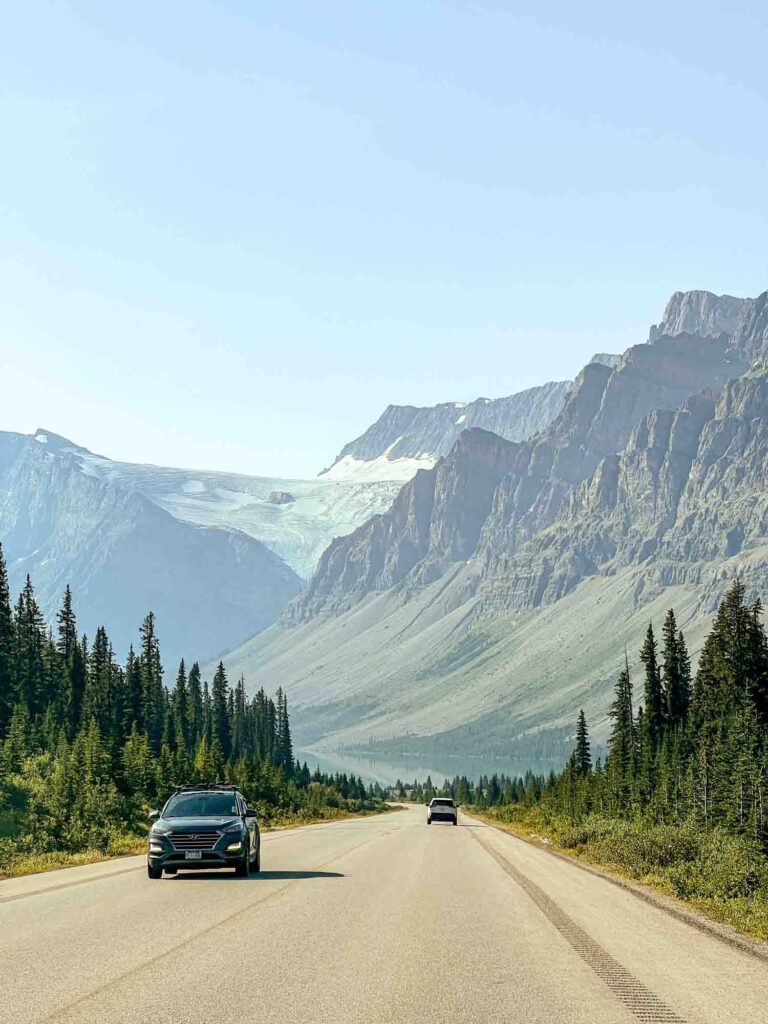

Even if you don’t have time to drive the entirety of the Icefields Parkway, it’s well worth driving at least a portion of it. We had limited time, and went only as far as Peyto Lake, but even that short portion was filled with some incredible views and I could not resist pulling out my camera every 10 seconds!
I could give you a list of attractions to stop at along the way, but I think some of the best photo ops come from just driving along the road and taking in the views. You’ll encounter majestic mountain peaks, sweeping valleys, and some breathtaking glaciers.
Keep your eyes peeled because I guarantee that you’ll get some incredible shots!

Banff Avenue
Banff may be known for its natural wonders, aka mountains and glaciers, but it’s also got a lively downtown area.
Banff Avenue is the main street downtown, and is lined with tons of restaurants, bars, cafes, and souvenir shops. It’s also super charming and photogenic, with storefronts inspired by Alpine Villages and flower pots all around the streets (it kinda reminded me of Leavenworth, WA in a way).
You’ll also get a gorgeous view of Cascade Mountain in all its glory – no hiking or climbing required!
You can catch the best views of Cascade Mountain at the southern end of Banff Avenue, but really, any part of the street is quite Instagram-worthy. I personally loved capturing the cute storefronts and flower pots in front of the mountain!
Also be sure to grab a bear claw or an ice cream cone from Cow’s – the view is the perfect backdrop when snapping a photo of your treat!
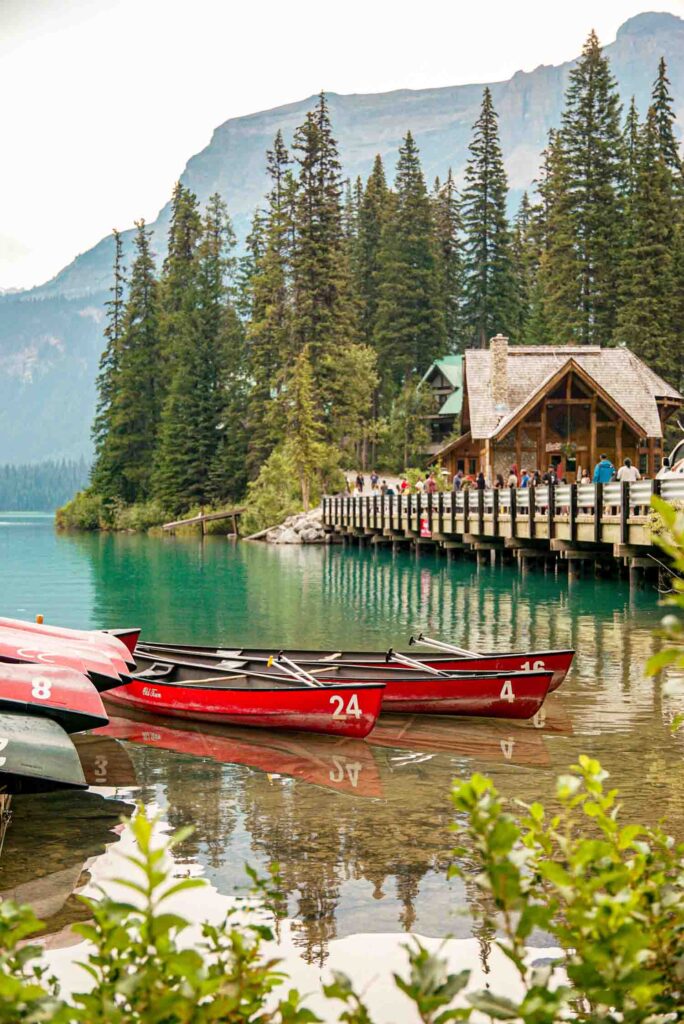
Emerald Lake
While Emerald Lake is technically outside of Banff National Park, it is close by and so beautiful that I had to include it on this list of Banff photo spots.
Emerald Lake is located in neighboring Yoho National Park (which is also technically located in British Columbia instead of Alberta), but it’s only about a 30 minute drive from Lake Louise, so it’s well worth a stop when trying to stop at all the best places to take pictures in Banff.
As the name implies, Emerald Lake is known for its gorgeous emerald colored waters, which are absolutely gorgeous. It’s known as another one of the most beautiful lakes in Canada, and one look at it and you’ll see exactly why.
Emerald Lake is magnificent from all angles, so you’ll be able to get some stunning shots just by walking around the lakeshore. However, I think the best views are from the side of the lake facing the lodge – you’ll get to capture the lake, lodge, mountains, and even the red boats, which add a bit of contrast.


We also went canoeing here, and loved it – the waters looked especially gorgeous while we were right on it. So beautiful!
Summer is the best time to capture the emerald color of the waters, although the lake also looks magical when surrounded by the snow-covered trees and mountains – truly a winter wonderland.
Emerald Lake really looks gorgeous at any time of the day. Coming mid-day when the sun is out will get you those sparkling emerald waters in your photos. Unfortunately, we came on a pretty gloomy day (it started pouring and thundering while we were here, so we didn’t get to stay as long as we wanted), but I thought the lake still looked pretty spectacular!
It also looks pretty incredible at sunrise and sunset.

Three Sisters Viewpoint
The Three Sisters viewpoint is one of the lesser known Banff photography spots.
Heck, I had no idea it existed until my friend Jess took us there (and then we were convinced that she was up to no good while we were on the way to get there). I don’t know if it has an official name, but it’s listed as the Three Sisters viewpoint on Alltrails, so I’m going with that.
The Three Sisters are a trio of mountain peaks, some of the most well-known in Canmore. While you can see them from almost anywhere in Canmore, this viewpoint is probably the best spot to photograph them.


The trail to the Three Sisters viewpoint starts from across the off-leash dog park (which is where you’ll park). You’ll cross underneath the road and railroad tracks (go underneath the bridge instead of jaywalking across because there are a lot of cars and it’s dangerous!).
You might think that you’re lost but don’t worry, you’re going the right way – and you’ll probably see a handful of other local photographers going the same way.
You’ll eventually come to a small trail that goes through the creek bed for about 0.5 miles. Soon, you’ll come to a small pond, with a view of the Three Sisters perfectly reflected onto it, which is the actual viewpoint.
We came to the Three Sisters viewpoint for sunset and it was so pretty, especially seeing the mountains and cotton candy clouds reflected onto the pond. However, I think it would be even better for sunrise, because you can see the sun come up from behind the mountains.

Johnston Canyon
Johnston Canyon is one of the most iconic sights in all of Banff. It’s one of the top Banff photo spots, with its tall limestone cliffs, vibrant blue pools, and gushing waterfalls,
The best thing about Johnston Canyon is that you don’t have to hike too far or hard to experience its beauty and to find some photo ops. If you’re not up for much of a hike, you can simply just head up to the Lower Falls, an easy one mile round-trip hike on a paved trail.
If you want a bit more of a challenge, continue onto the trail to the Upper Falls, where you’ll find the Instagram-famous view of the falls. The trail is a 3.4 mile round-trip hike and gets noticeably steeper at this point, but it’s worth it – you’ll see the falls dropping 30 feet into an electric blue pool below.


Still can’t get enough? You can also hike to the Ink Pots, a series of seven vibrant green and blue pools which get their colors from the minerals in the water. Each pool has a different color, as they all have a different fill rate. The water is so clear that they resemble glass!
You’ll find plenty of photo-worthy views at Johnston Canyon. Obviously, the waterfalls and pools are the star here. But look beyond that and look around to find some other photo ops – for example, the wooden boardwalks and footbridges make for some fun shots as well!
Coming to Johnston Canyon in the summer, particularly in the months of June and July, will give you the best shots of the waterfalls at their peak. However, this is one of the best places to visit in Banff in the winter – it is magical to see the falls frozen over!
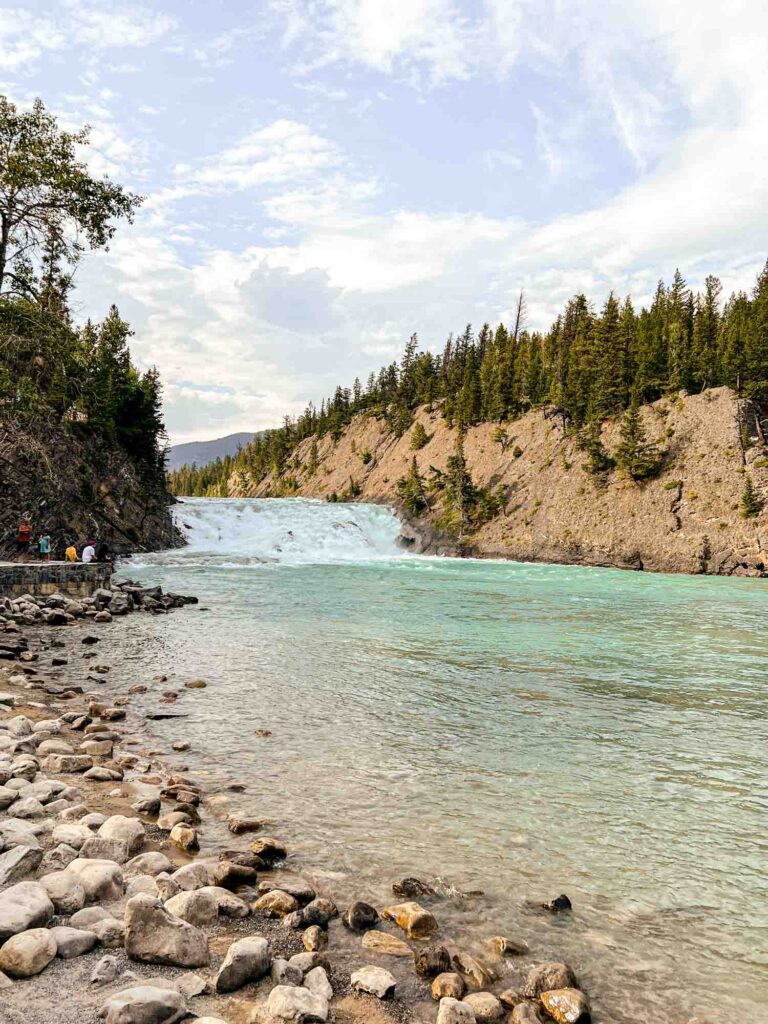
Bow Falls
Bow Falls is only 9 meters tall, so it’s not tall by any means. So you might be asking – why bother including it as one of the best Banff Instagram spots?
While it isn’t very tall, Bow Falls is gorgeous, surrounded by rocky cliffs and beautiful scenery. It’s also so accessible from Banff town – just a 5 minute drive or 15 minute hike – that it’d be a shame to miss it.
The falls are famous and have made an appearance in several 1950s films, most notably River of No Return starring Marilyn Monroe.
Bow Falls is photo-worthy from any angle, but if you go further back from the viewpoint, you can capture it with the mountains in the back. Use a zoom lens to make the mountains look bigger to make them more majestic!
It’s a beautiful sight no matter what time of year you visit – in the summer, the falls are gushing, and in the winter they look spectacular when frozen over.

Fairmont Banff Springs
The Fairmont Banff Springs is one of the most iconic and luxurious hotels in the area. It’s also one of the most beautiful – I mean, it’s an actual castle y’all (just like the Chateau Frontenac in Quebec City)!
While you can photograph the Fairmont Banff Springs while you’re there (check out the views from the patio in the bar area too!), there’s actually a viewpoint of it that’s also one of the best places to take pictures in Banff.
To capture the most magical shots of the Fairmont Banff Springs, head on over to Surprise Corner. Located right off Tunnel Mountain Drive, the viewpoint is right along the Bow River (it’s actually right across the river from the Bow Falls viewpoint that I talked about earlier).
You’ll see the Fairmont Banff Springs surrounded by the forest (it kind of reminds me of how Neuschwanstein Castle stands out amongst the trees from certain angles), and it looks straight out of a fairytale!
It’s a beautiful view no matter what time of year, but it is especially magical in the winter, when it is all covered in a layer of snow – absolutely stunning!

Lake Minnewanka
Lake Minnewanka sometimes gets overshadowed by the other lakes in the area – I mean, there are so many spectacular lakes in Banff! Still, it’s beautiful in its own way and is one of the best photo spots in Banff.
It’s the largest lake in Banff (and one of the largest in Alberta), and is surrounded by gorgeous mountains which reflect onto its emerald waters.
There’s no single best photo spot at Lake Minnewanka, and its beauty can be captured by anywhere along the lake. The shore is massive – the entire Lakeshore Trail stretches a whopping 16 kilometers – but you’ll still find plenty of photo ops even if you only do a small part of it.
You can capture the boats in the water from the docks, or you can get on the water yourself – this is an awesome spot to go canoeing, kayaking, or SUPing, and the lake cruise is one of the most popular activities in Banff.
Lake Minnewanka is gorgeous year-round – in the summer, you’ll catch the emerald color of its waters, the lake is surrounded by vibrant foliage in the fall, and you’ll get to see it frozen over in the winter, when you can actually walk out onto the lake.
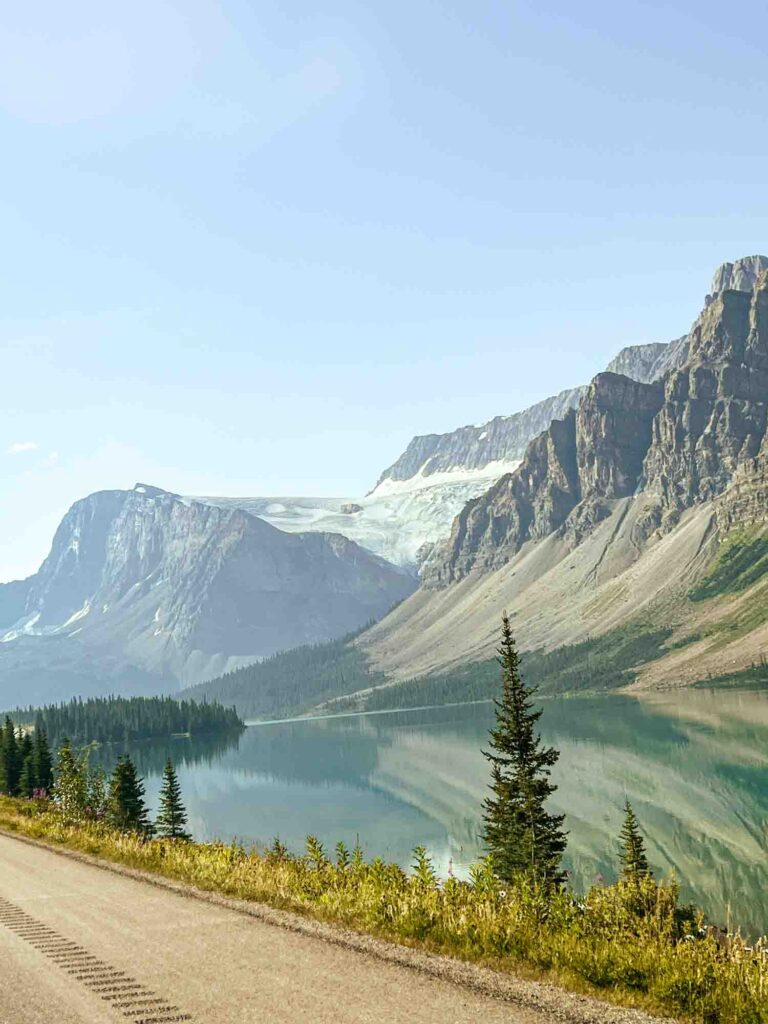
Bow Lake + Crowfoot Glacier
Bow Lake is one of the first stops along the Icefields Parkway as you leave Banff, and it is one of the most photogenic.
Even if you only catch a glimpse of it from the road, or stop at the viewpoint for a few minutes, the lake is spectacular. The glacial lake has a vibrant turquoise color that will take your breath away!
If you have a bit more time, there are a number of trails that go around the lake that you can explore. One of the best photo spots is along the wooden bridge that leads out onto the lake.
Bow Lake is surrounded by Crowfoot Mountain, which has an impressive glacier hanging over it, one of the best that I saw! You can catch a view of it from the lake, or you can also stop at the Crowfoot Glacier viewpoint to get a really good view of it.
Have you ever been to Banff? What are some of your favorite Banff photo spots?
You might also enjoy:
The Complete 3 Days in Banff Itinerary
The Perfect 2 Days in Vancouver Itinerary
Liked this post? Save these Banff Instagram spots to Pinterest for later!


Caroline is a Southern California based traveler, writer, and photographer. She travels all around California, the US, and the world in search of the most colorful places, the most delicious food, and bucket-list adventures. Her aim is to inspire other travelers discover how to add more adventure and joy to their lives. On Pictures & Words, you’ll find detailed guides + itineraries, along with vibrant photos to help you plan the the most epic trips. When she’s not traveling, Caroline also runs half marathons.
